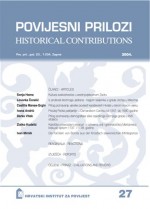Kultura svakodnevice u srednjovjekovnom Zadru
The culture of daily life in medieval Zadar
Author(s): Sonja HomaSubject(s): History
Published by: Hrvatski institut za povijest
Keywords: Zadar; Dalmatia; the Middle Ages; social history; economic history; the culture of living
Summary/Abstract: The analysis of the culture of living in Zadar in the Middle Ages encompassed the testamentary material from the five volumes of the Files of notaries from Zadar, the Miscellanea collection and the previously analyzed sources such as a very extensive inventory of Mihovil Petrov from the monastery of St. Mary, the inventory of Grizogono, the late Lovro de Civalellis, a patrician from Zadar, and the testament of a patrician of Croatian descent Krešo Varikaša from Zadar. The mentioned private legal sources include testaments and inventories connected to the city of Zadar and its district formed in the period between the second half of the XVIII century and the beginning of the XV century. Data analysis included available facts about the testator, movables and immovables and categories other than movables and immovables such as charities or interment practices that are important in order to understand beliefs and principles characteristic of a certain socio-historical community. Reasons for writing a testamentary document should be looked for in religious politics that propagated the necessity of receiving God’s mercy as a condition for the continuity of existence while caring for progeny and their existence is less important. Overall, the gathered data is not a good indicator of the actual situation since only a small percentage of the original sources was preserved and it, in most part, refers to a higher legal population category that was surely not prevailing. Based on the results, it can be concluded that the greatest disparity in proprietary relations between social groups is not in type, numerosity and material of different objects that are in one's possession and in their quality of workmanship but in the object itself. The way of living and organization of residential/business space shows similarity to other Dalmatian communes and distant cities in the western European area. Individual abundance of property evident in expensive articles of clothing, valuable tableware or literature in general is following European trends of that time thus showing that Zadar, with its small but significant part of population, follows the cultural trends of its time in different aspects.
Journal: Povijesni prilozi
- Issue Year: 2004
- Issue No: 27
- Page Range: 7-34
- Page Count: 29
- Language: Croatian

